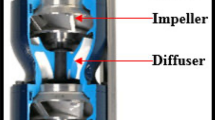Abstract
Seawater pumped storage consists of pumping water from the sea to an upper reservoir to store electricity. The use of seawater as the fluid results in an erosion mechanism due to the presence of solid particles. In this paper, we study the effect of the fluid content on the performance of low-head pumps in the blade-to-blade section. The loss of blade thickness may cause damage due to the water pressure applied to the blade section. From our study, we conclude that the resulting erosion depends on the absolute velocity distribution whereas the thickness loss depends on the particle size, density, and velocity. For hydraulic pumps, erosion of the blades is more likely to occur at their trailing edge. A reduction of the blade orthogonal thickness to 10% results in flow deflection.




























Similar content being viewed by others
Abbreviations
- U :
-
Centrifugal velocity (m/s)
- C :
-
Absolute velocity (m/s)
- C u :
-
Tangential velocity (m/s)—the tangential component of C
- C m :
-
Meridional velocity (m/s)—the axial component of C
- W :
-
Relative velocity (m/s)—the velocity of the fluid due to the impeller rotation frame
- V erosion :
-
Erosion velocity (m/s)
- t :
-
Blade thickness (m)
- σ :
-
Blockage ratio
- γ :
-
Slip factor
- β :
-
Blade angle (degrees)
- η H :
-
Hydraulic efficiency (%)
- α :
-
Flow angle (degrees)
- N p :
-
Particle number (considered to be 20 for all simulations)
- V p :
-
Particle velocity (m/s)
- r p :
-
Particle velocity (m)
- d p :
-
Particle density (kg/m3)
- z :
-
Number of runner blades
- dS :
-
Shroud diameter (mm)
- CFD:
-
Computational fluid dynamics
- Re:
-
Reynolds number
- v p :
-
Vapor pressure
- H E :
-
Effective head (m)
- 1:
-
Entrance section (LE)
- 2:
-
Outlet section (TE)
- p:
-
Particle
- SW:
-
Seawater
- ss:
-
Shroud suction section
- sp:
-
Shroud pressure side
- s:
-
Shroud
- h:
-
Hub
- hs:
-
Hub suction side
- hp:
-
Hub pressure side
References
Adnan Aslam Noon M-HK (2021) Sediment and cavitation erosion in Francis turbines—review of latest experimental and numerical techniques. Energies. https://doi.org/10.3390/en14061516
Aungier R (2000) Centrifugal compressors: a strategy for aerodynamic design and analysis. 2000 (p. Chap 7).
Ayancik F (2014) Parametrical and theoretical design of a Francis turbine runner with the help of computational fluid dynamics. In: HEFAT2014 10th international conference on heat transfer, fluid mechanics and thermodynamics, 2014. https://doi.org/10.13140/2.1.3604.7683
Bardal E (1985) Korrosjon og korrosjonsvern
Biraj Singh Thapa BT, Dahlaug OG (2012) Empirical modelling of sediment erosion in Francis turbine. Energy. https://doi.org/10.1016/j.energy.2012.02.066
Dixon SL, Hall CA (2014) Chapter 9—hydraulic turbines. In: Dixon SL, Hall CA (eds) Fluid mechanics and thermodynamics of turbomachinery (seventh edition). Butterworth-Heinemann, Boston, pp 361–418
Finnie I (1960) Erosion of surfaces by solid particles. Wear 3(2):87–103. https://doi.org/10.1016/0043-1648(60)90055-7
Gautam S et al (2020) Sediment erosion in low specific speed Francis turbines: a case study on effects and causes. Wear 442–443:203152–203152. https://doi.org/10.1016/j.wear.2019.203152
Gülich JF (2014) Centrifugal pumps 7–10
Hashimoto T (1986) Seawater pumped storage scheme under study in Japan. International water power and dam construction
Koirala R et al (2016) Sediment erosion in guide vanes of Francis turbine: a case study of Kaligandaki hydropower plant, Nepal. Wear 362–363:53–60. https://doi.org/10.1016/j.wear.2016.05.013
Messa GV, Mandelli S, Malavasi S (2019) Hydro-abrasive erosion in Pelton turbine injectors: a numerical study. Renew Energy 130:474–488. https://doi.org/10.1016/j.renene.2018.06.064
Padhy MK, Saini RP (2011) Study of silt erosion on performance of a Pelton turbine. Energy 36(1):141–147. https://doi.org/10.1016/j.energy.2010.10.060
Sangal S, Singhal MK, Saini RP (2018) Hydro-abrasive erosion in hydro turbines: a review. Int J Green Energy 15(4):232–253. https://doi.org/10.1080/15435075.2018.1431546
Schwanse M (1990) Strömungsmechanische Auslegung und Nachrechnung von radialen und diagonalen Kreiselpumpenlaufrädern (in German). Dissertation, 1990, pp 60–70
Author information
Authors and Affiliations
Corresponding author
Ethics declarations
Conflict of interest
On behalf of all authors, the corresponding author states that there is no conflict of interest.
Additional information
Responsible Editor: Mohamed Ksibi.
Rights and permissions
Springer Nature or its licensor (e.g. a society or other partner) holds exclusive rights to this article under a publishing agreement with the author(s) or other rightsholder(s); author self-archiving of the accepted manuscript version of this article is solely governed by the terms of such publishing agreement and applicable law.
About this article
Cite this article
EL Mansour, J., Hendrick, P., Hajjaji, A. et al. The effect of erosion on hydraulic machine performance. Euro-Mediterr J Environ Integr (2024). https://doi.org/10.1007/s41207-024-00480-9
Received:
Accepted:
Published:
DOI: https://doi.org/10.1007/s41207-024-00480-9




